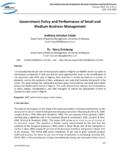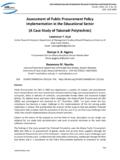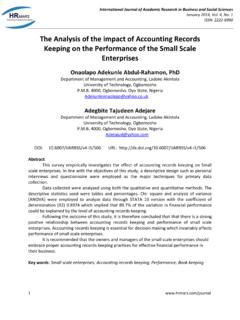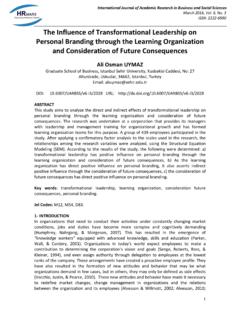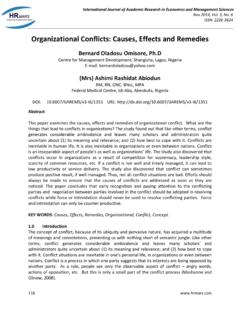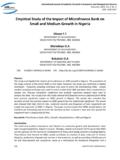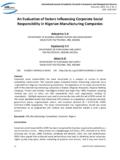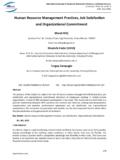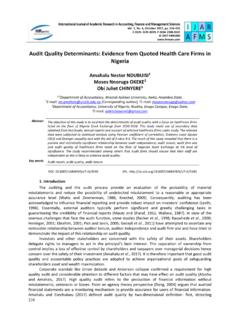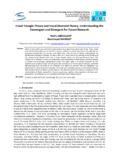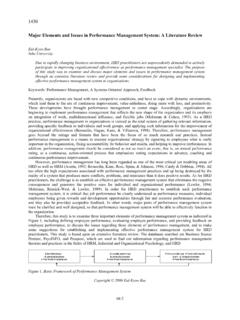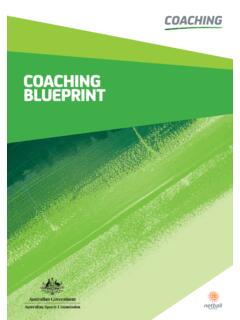Transcription of A Review of Coaching and Mentoring Theories and Models
1 International Journal of Academic Research in Progressive Education and Development Vol. 9, No. 2, 2020, E-ISSN: 2226-6348 2020 HRMARS 289 Full Terms & Conditions of access and use can be found at A Review of Coaching and Mentoring Theories and Models Mastura binti Kamarudin, Azni Yati binti Kamarudin, Ramiaida binti Darmi, Noor Saazai binti Mat Saad To Link this Article: Received: 21 March 2020, Revised: 27 April 2020, Accepted: 10 May 2020 Published Online: 18 June 2020 In-Text Citation: (Kamarudin et al., 2020) To Cite this Article: Kamarudin, M. binti, Kamarudin, A. Y. binti, Darmi, R. binti, & Saad, N. S. binti M. (2020). A Review of Coaching and Mentoring Theories and Models . International Journal of Academic Research in Progressive Education and Development, 9(2), 289 298.
2 Copyright: 2020 The Author(s) Published by Human Resource Management Academic Research Society ( ) This article is published under the Creative Commons Attribution (CC BY ) license. Anyone may reproduce, distribute, translate and create derivative works of this article (for both commercial and non-commercial purposes), subject to full attribution to the original publication and authors. The full terms of this license may be seen at: Vol. 9(2) 2020, Pg. 289 - 298 JOURNAL HOMEPAGE International Journal of Academic Research in Progressive Education and Development Vol. 9, No. 2, 2020, E-ISSN: 2226-6348 2020 HRMARS 290 A Review of Coaching and Mentoring Theories and Models Mastura binti Kamarudin Universiti Sains Islam Malaysia, 71800, Negeri Sembilan, Malaysia Azni Yati binti Kamarudin University of Malaya, 50603, Kuala Lumpur, Malaysia Ramiaida binti Darmi, Noor Saazai binti Mat Saad Universiti Sains Islam Malaysia, 71800, Negeri Sembilan Malaysia,Malaysia Abstract This paper encapsulates the Theories and Models within the Coaching and Mentoring process.
3 Three major Theories and Models are discussed and relate to the Coaching and Mentoring situation: Zone of Proximal Development (ZPD), Biggs s Presage-Process-Product Model and The GROW Model. These Models play a significant role in Coaching and Mentoring whereby both involve in the process to maximise the potential of the clients or coaches. A series of meeting, building rapport and rightly questioning and answering techniques could build up the best of coaches and clients. At the same time, the mentors must be able to model the action they want their mentee to adopt. Thus, these Theories and Models should be fully understood and applied by mentors and mentees to increase their quality. Keywords: Coaching , Mentoring , Clients, Theories , Potential.
4 Introduction The aim of this paper is to explore into, and understand, Theories and Models within the Coaching process. The researcher reviewed Theories and Models related to Coaching and Mentoring in order to lay a more or less solid foundation upon which Coaching and Mentoring can be based. Then, the validation of theory and Models is established and their contribution to the issue of Coaching and Mentoring analysed. The Review of these Theories and Models are essential because it helps to unveil a deep concern for the Coaching and Mentoring relationship. There are two Theories and one model that have become the mainstay of this study. They are Zone of Proximal Development (ZPD), Biggs s Presage-Process-Product Model and The GROW Model.
5 They are to be discussed in order. International Journal of Academic Research in Progressive Education and Development Vol. 9, No. 2, 2020, E-ISSN: 2226-6348 2020 HRMARS 291 Coaching Basically, Coaching is a central component of successful professional development. According to Whitmore (2002), Coaching refers to unlocking a person s potential to maximise their own performance . Du Toit and Reissner (2012) posited that Coaching is the ability to increase and improve the sensitivity and awareness that the client has within himself or herself, and for others. To develop self-awareness, an individual must have access to honest feedback and this is sometimes difficult to obtain within the organisation, particularly if the client is in a senior position within the organisation.
6 Coaching is an enabling process aiming at enhancing learning and development with the intention of improving the performance in a specific aspect of practice (Lord et al. 2008). Coaching is the main component of a successful professional development that will become a form of support to reveal a person s potential to maximise their own performance . Coaching offers support for the learners' ability to transfer their learning to succeed in complex and independent performances. According to Lord et al. (2008), Coaching is an enabling process that aims at enhancing learning and development with the intention of improving the performance in a specific aspect of the practice (Lord et al., 2008). Therefore, in this study Coaching is defined as the ability of a coach to offer additional professional support in helping the coachees to exploit and increase their performance in certain subjects, namely Mathematics, Bahasa Melayu and English Language.
7 The emphasis will be on continuous collaboration, support for lesson planning and teacher placement so that the 21st century teaching and learning in the classroom can become the focal point of their teaching. Mentoring Mentoring refers to a process of serving as a mentor, or someone who facilitates and assists another person s development. The process of Mentoring includes modelling because the mentor must be able to model the messages and suggestions being taught to the beginning teacher (Gay, 1995). With regard to this study, Mentoring is a process where the SISC+ or the coaches demonstrate a range of cognitive Coaching competencies, such as posing carefully constructed questions to stimulate reflection, paraphrasing, and using data to improve teaching and learning.
8 Ganser (2006) stated that Mentoring was a tool which had remained very significant in improving management skills and staff development. Hence, Mentoring is a dynamic relationship that leads to the creativity, professional growth and mastery over problem-solving techniques. Nonaka and Nishiguchi (2001) mentioned that workplace relationships such as Mentoring should be fostered to encourage the transfer of implied knowledge. The nature of Mentoring is a collaborative and mutually beneficial approach between mentor and mentee, as Lim (2005) revealed. Thus, Mentoring is a factor that promotes guidance on career development and role modelling where both contribute significantly to employee s development. Scandura, Gavin and Williams (2009), emphasised that Mentoring relationships can significantly affect individual career development and advancement with both the mentor and the mentee benefiting from the relationship.
9 Zone of Proximal Development (ZPD) and Scaffolding Vygotsky s description of the zone of proximal development (ZPD), is the distance between what an individual can achieve individually and what he or she is capable of accomplishing with International Journal of Academic Research in Progressive Education and Development Vol. 9, No. 2, 2020, E-ISSN: 2226-6348 2020 HRMARS 292 more expert assistance (Vygotsky, 1978). It is vital to note, however, that the term was never used by Vygotsky in his writing, but it was introduced by Wood & Wood (1996). Cole & Cole (2001) point out that the term specifies that the support provided goes just slightly beyond the learner s present competence complementing their existing abilities. The key point of the concept developed by Vygotsky refers to the difference between a learner s ability to perform a task independently and guidance.
10 The theory of Zone of Proximal Development (ZPD) has deliberated by Vygotsky. A ZPD can be created for any field of skill. This concept has a significant contribution to the field of education and is used in developing age-appropriate curriculum and teaching techniques. In the education domain, teaching and learning occur when help is offered at points in the ZPD, at which performance requires help. The assistance is provided by the teacher, the expert, or a more capable person in giving help or assistance. Consequently, teaching consists of assisting performance through the ZPD. As pointed out by Rasmussen (2001), ZPD is a form of support for the development and learning of children and young people. Jacobs (2001) describes ZPD as the way teachers or peers supply students with the tools they need in order to learn.
